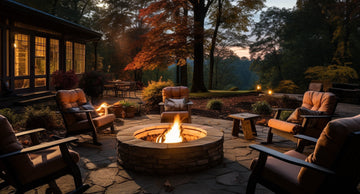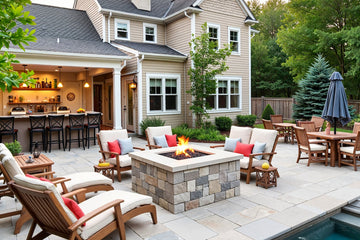Fire Pit Maintenance 101: Keeping Flames Bright All Year
by Kim Sheppard on Jul 03, 2025

Gas fire pits are a stunning and functional addition to any outdoor living space. They offer warmth, ambiance, and a cozy focal point for gatherings year-round. But to keep those flames burning safely and beautifully, your gas fire pit requires regular care and attention. Whether you’re using a natural gas line or propane, proper maintenance is key to extending the life of your investment and keeping your outdoor space ready for every season.
At RTF Systems, we help homeowners design and install premium outdoor fire features, and we know that longevity comes down to how well you maintain what you’ve built. In this guide, we’ll walk you through everything you need to know about gas fire pit maintenance—from cleaning and inspections to seasonal adjustments and troubleshooting tips—so your fire pit stays safe, efficient, and bright all year long.
Why Fire Pit Maintenance Matters
Like any outdoor appliance, a gas fire pit is exposed to the elements—rain, dust, wind, bugs, pollen, and even small animals. Over time, debris can clog burners, corrode components, and interfere with fuel flow. Regular maintenance helps prevent these issues before they escalate into bigger (and more expensive) problems.
Beyond performance, there’s also the issue of safety. Improperly maintained gas lines or burners can lead to gas leaks or uneven flame patterns, both of which pose a fire hazard. Taking the time to care for your fire pit helps ensure not only a beautiful flame but also peace of mind.
Weekly & Monthly Maintenance Tasks
If you’re using your gas fire pit regularly, especially during the cooler months or hosting season, a quick weekly check can keep everything running smoothly.
Start by wiping down the exterior with a soft, damp cloth to remove dirt, dust, and grease. Avoid abrasive cleaners, especially if your fire pit has a powder-coated or stainless steel finish. This keeps it looking new and prevents premature wear.
Inspect the burner openings for any clogs or debris—spider webs, leaves, or insects are common culprits that can restrict gas flow. If you notice any blockage, use a soft-bristled brush or compressed air to gently clean them out.
Once a month, check your ignition system. Whether your pit uses a push-button igniter, electric spark, or match light, it’s crucial that the ignition works cleanly and reliably. If there’s any hesitation or failure to ignite, inspect for corrosion or a weak battery in electronic igniters.
Seasonal Deep Cleaning for Fire Pits
At least once a season—ideally in the spring and fall—plan for a deeper inspection and cleaning session. Start by turning off the gas completely and allowing the unit to cool before you begin.
Remove the decorative media, such as lava rock, fire glass, or ceramic logs. These can accumulate soot or grease over time and should be gently washed with warm, soapy water and thoroughly dried. Avoid soaking porous materials like lava rock, as moisture trapped inside can cause cracking when exposed to high heat.
Once the media is out, inspect the burner pan and gas line connections. Look for rust, cracks, or loose fittings. Tighten connections as needed, but never attempt to repair or replace gas components unless you’re a licensed professional. If you smell gas or suspect a leak, shut off the system and call a qualified technician.
Clean the burner ports with a wire brush or pipe cleaner to ensure an even gas flow. These tiny openings can become clogged with ash, soot, or mineral buildup, resulting in inconsistent flames or poor performance.
Also, check your drainage system. Many fire pits include weep holes or drainage ports to prevent water buildup in the burner tray. Make sure these are clear of blockages so rain or condensation can escape freely.

Fire Pit Cover It Up: Protection Is Prevention
One of the easiest and most effective ways to protect your gas fire pit is by using a high-quality, weatherproof cover. A fitted cover keeps out moisture, pests, UV rays, and falling leaves—reducing the time you’ll spend cleaning and preventing long-term damage.
Covers are especially critical if you live in a region with harsh winters or frequent rain. Snow and ice can be particularly damaging to burner components and gas lines. Covering your fire pit between uses can easily double its lifespan.
Propane Tank Safety and Storage
If your gas fire pit uses a portable propane tank, it’s important to inspect the tank and fittings regularly. Look for signs of rust, dents, or leaks. Use soapy water to test for gas leaks around the regulator and hose fittings—if you see bubbles, shut off the tank and replace the faulty part immediately.
Store propane tanks in an upright position in a shaded, ventilated area away from heat sources. Never store tanks indoors or in enclosed spaces like garages. During winter, consider removing the tank altogether and storing it in a designated outdoor cabinet.
Maintaining Natural Gas Fire Pits
For fire pits connected to a natural gas line, annual professional inspections are a smart investment. A licensed gas technician can check for pressure levels, leaks, and corrosion in buried or exposed lines. This is especially important in climates where freeze-thaw cycles can shift underground piping.
If you’ve recently gone several months without using your fire pit, test the system before lighting a full flame. Turn the gas on briefly and listen for any unusual sounds or hissing. If anything seems off—or if the flame pattern is erratic—it’s time to schedule service.
Keeping the Flame Even and Bright
A strong, consistent flame is not only visually appealing—it’s a sign your system is functioning properly. Uneven or yellow flames can be caused by blocked burners, low gas pressure, or moisture buildup in your media. Regular cleaning, coupled with annual inspections, helps ensure your fire pit stays as mesmerizing on day 100 as it was on day one.
Avoid burning paper, trash, or wood in your gas fire pit. Doing so can create soot buildup, damage the burner, and void your warranty. Only use the recommended fire media for your unit, and keep flammable items like furniture cushions or umbrellas safely distanced.
Winterizing Your Gas Fire Pit
If you don’t plan to use your fire pit during the winter, taking time to properly shut it down will prevent damage and simplify spring setup. First, disconnect and store your propane tank or shut off the natural gas supply valve. Clean the unit thoroughly—removing fire media, wiping down surfaces, and clearing drainage holes.
Once clean and dry, cover the entire unit with a weatherproof cover designed for your model. If your fire pit is built into a countertop or enclosure, ensure surrounding surfaces are also protected from snow or debris.
In areas with frequent freezes, consider installing a gas line shut-off valve if you don’t already have one. This allows you to isolate the fire pit from your home’s gas supply and prevent pressure buildup during temperature fluctuations.
When to Call a Professional
While many maintenance tasks can be done by homeowners, certain issues require a licensed technician. Call a pro if you notice:
-
A persistent gas smell even when off
-
Cracks or corrosion on gas lines or fittings
-
Weak or uneven flame despite cleaning
-
Ignition system failures that aren’t battery-related
-
A clicking sound with no ignition
Attempting to fix these issues without the proper tools or certifications can be dangerous. A professional will not only diagnose the problem but also ensure your system meets local safety codes and manufacturer guidelines.
Fire Pit Maintenance Checklist
Here’s a quick summary of what you should keep an eye on throughout the year:
Weekly/Monthly:
-
Wipe down exterior
-
Clear burner ports of debris
-
Check ignition system function
-
Inspect propane tanks or gas connections
Seasonally:
-
Remove and clean fire media
-
Inspect burners, pans, and fittings
-
Check for gas leaks or unusual smells
-
Clear drainage systems
Annually:
-
Schedule a professional inspection (especially for natural gas)
-
Replace worn components or hoses
-
Winterize before freezing weather
Final Thoughts: Keep the Fire Burning Bright
A well-maintained gas fire pit brings joy and comfort to your outdoor space—without the hassle of constant repairs or safety risks. With a simple routine and occasional professional help, you can keep your fire pit in top condition for years to come.
At RTF Systems, we don’t just build outdoor fire features—we design them to last. Whether you’re installing a new gas fire pit or need service on an existing one, our team is here to help you enjoy your outdoor space safely and beautifully in every season.
Contact RTF Systems today to schedule a consultation or learn more about our custom fire pit solutions.



